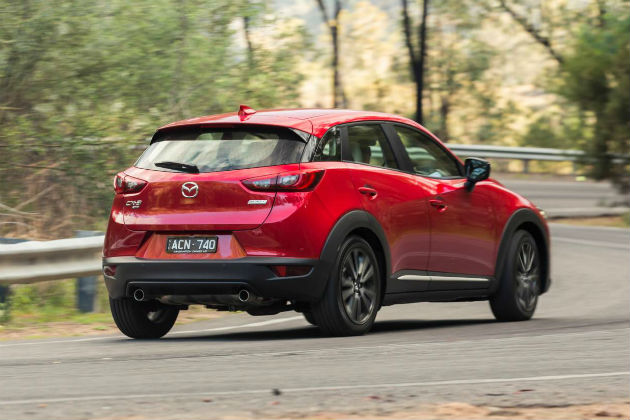21 January, 2016 By: Alex Forrest
There was a quite a lot of anticipation ahead of the Mazda CX-3 launch in March 2015.
So much in fact, that in the 10 months to the end of 2015 the baby Mazda SUV shot from zero to having the third biggest share of the small SUV market after the Mitsubishi ASX and the now-discontinued Hyundai ix35.
People were keen on this little Mazda2 on stilts, and despite being smaller than most of its competitors, it’s settled into a strong position in the market, selling more units than most small SUVs which were on sale for the full calendar year.

Part of the reason for that is the CX-3’s startling looks, which include Mazda’s bold grille and flowing side body design which Mazda tells us is its Kodo design language.
The CX-3 is also very keenly priced, starting at $23,000 drive away for the base petrol model with a six-speed manual.
What it also has going for it is its sharp handling – in fact it’s among the best in the segment on this front, up there with the Volkswagen Tiguan.
Although it’s based on the Mazda2 platform, the CX-3 is quite a different vehicle, offering all-wheel drive, more ground clearance, a diesel engine option and a host of safety kit which isn’t available on the little 2.
The CX-3 comes in three equipment grades, comprising the entry level Neo, then the Maxx, sTouring and the Akari.

Engine choices comprise a 2.0-litre petrol engine (109kW, 192Nm) and a 1.5-litre diesel (77kW, 270Nm), although the diesel isn’t available in the Neo.
We’ve just hopped back into a CX-3 after having last driven one in May 2015.
The variant we tested was the sTouring AWD Safety with the 1.5-litre diesel and a six-speed auto. In short, what that all that means is it’s one of the pricier CX-3s, and will require $37,000 drive away.

For that, you get kit such as 18-inch wheels, LED headlamps and daytime running lights, rain-sensing wipers, keyless entry and a head-up display. The test vehicle also had the safety pack, which at an extra $1,030, brings auto braking, rear cross traffic alert and a blind spot warning system.
With all those extra sets of eyes watching out, you do feel better in the knowledge there are some electronic angels looking out for you.
However, what we did find odd was that the side mirrors were flat, and not convex as has been the case in most new cars for more than 20 years.
This was a little unnerving in traffic, given the breadth of rearward vision was much narrower than we were used to. The blind spot warning system did compensate to some extent though.
Also requiring some adjustment was the CX-3’s high-sided styling. As a driver you feel ensconced, although kids do have trouble seeing out, especially when they’re in the back where the CX-3’s hipline rises even further.

It was interesting to spend some time revisiting the diesel. In SUVs, our preference is often the diesel version because of their torque delivery characteristics, however in the case of the CX-3 we’d go for the 2.0-litre petrol.
The tiny 1.5-litre diesel is relatively smooth when under way, but it does have some lag to it and when the torque does come in, it’s not to the muscular extent you’ve been waiting for.
Go for the 2.0-litre petrol – the vehicle is light enough for its lower torque to handle, and the 2.0-litre petrol’s healthier power output makes the CX-3 much better suited to open-road driving. Plus, it’s smoother.
Fuel consumption of the diesel is very low though, at 4.8L/100km in the ADR test. Though around town, we recorded an average of 6.5L/100km. The 2.0-litre petrol used 6.7L/100km in the official test.
The Mazda CX-3 carries a 5-star ANCAP safety rating.
| Price driveaway (as tested): |
$23,000 |
|---|---|
| Engine: | 1.5-litre four-cylinder turbo diesel |
| Power: | 77kW @ 4000rpm |
| Torque: | 270Nm @ 1600rpm |
| Claimed fuel economy: | From 5.1L/100km |
| ANCAP Rating: | 5 stars |
| CO2 Emissions: | 134g/km |
The diesel variants of this vehicle qualify for RAC's Less Emissions Mission rewards.
